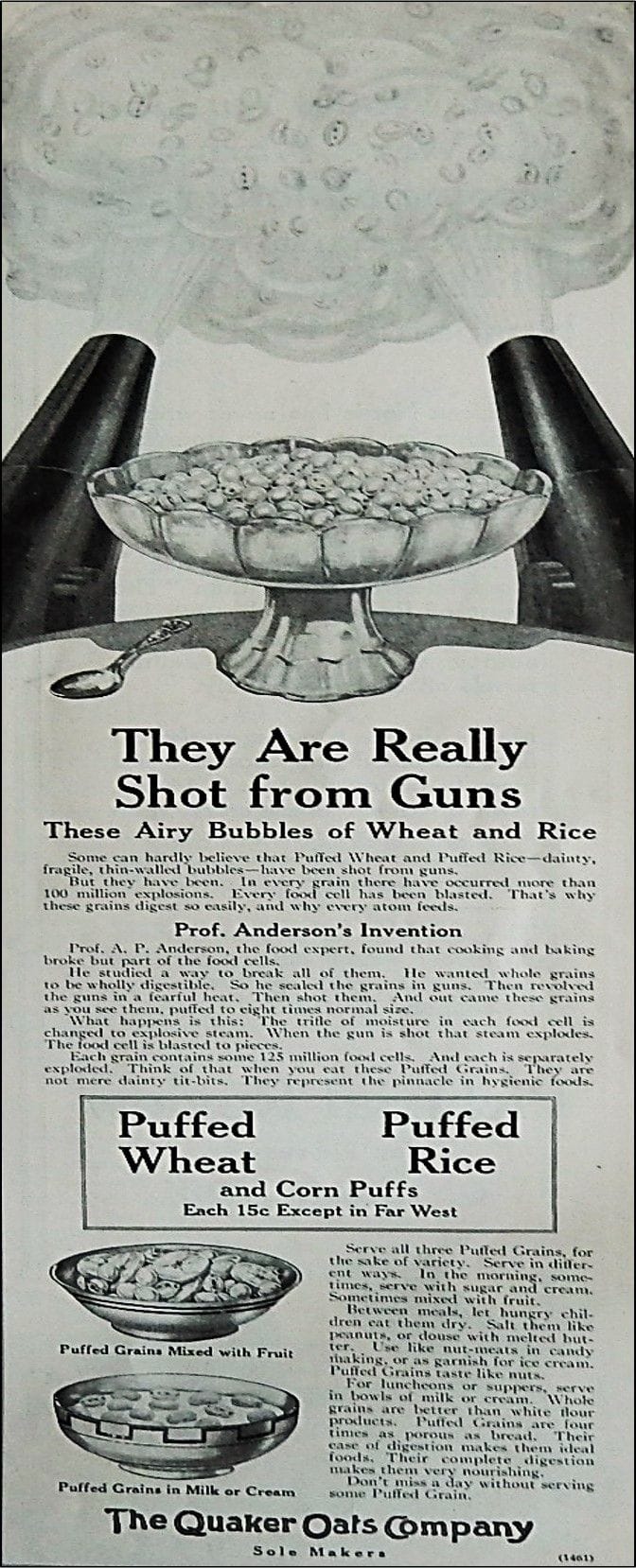Long-Lasting Lessons from Claude Hopkins Most Successful Advertising Campaigns (PART IV)
The Puffed Cereals Campaign
Picture this, eight 20-inch-long bronze cylinders blasting puffed rice inside a giant cage.
A scene from a comedy?
A circus act?
No. It was the way Alexander P. Anderson chose to show his invention at the 1904 World’s Fair.
It was a small-scale demonstration of the puffing process, something that would revolutionize the breakfast world.
It’s time for another Claude Hopkins successful campaign.
Advertising Project - Quaker Oats Company
Strategy
Create a personality to give a human touch and build curiosity around your product.
The Product
Puffed cereals
The Campaign
Anderson puffed more than 20,000 pounds of rice by the end of the 1904 World’s Fair. It showed such commercial potential that the Quaker Oats Company acquired the invention.
They soon started large-scale production of puffed rice and wheat cereals and contacted Claude Hopkins to run their advertising campaigns.
With a $50,000 budget, Claude chose to promote Puffed Rice and Wheat Berries. Both products have something unique but poor sales. He realized that, in order to justify the advertising cost, he had to sell both products together.
The first step, rename Wheat Berries. For now on, it was called Puffed Wheat.
The second step was research. As you know, if you have read my previous articles, Claude was known for researching the product carefully, always looking for reasons why the customer should buy it.
He visited the production plant accompanied by Alexander P. Anderson, the inventor. He saw how they placed raw grains in long metal cylinders that look like cannons and then, injected hot compressed air into the tubes. The grains expanded to about eight times their original size. When they opened the cylinders, the compressed air exploded out carrying with it the puffed cereals.
A company historian described the machine as “a muzzle-loading cannon of murderous caliber that would have been in place on a colonial frigate.”
It left a strong impression.
Claude proposed the soon-to-be-famous phrase “Food shot from guns” to advertise the product.
It wasn’t well received.
The main concern was that the target market, women, will not find the idea appealing. Mixing food and guns in the same sentence was weird.
An article from the press said it was “the theory of an imbecile.”
They were wrong.
The phrase caught people's attention and created curiosity and desire to try the product.
Both products were soon the most profitable breakfast food on the market.
Years later, this phrase was still pitched in ads by major Hollywood stars such as Shirley Temple and Bette Davis.

For this campaign, Claude created a personality, Professor Alexander P. Anderson, the inventor of the puffing machine. He considered it more appealing than using a soulless brand.
Anderson's name and image appeared in magazine ads with headlines such as:
“Prof. Anderson’s Story”
“Prof. Anderson’s Invention”
“All Because Prof. Anderson Thought of Exploding Grain”
“What Prof. Anderson Did for Your Doctor”
“He Invented Food Shot from Guns”

In every ad, the reader could picture grains eight times bigger than their original size and learn why the cereals puffed.
The ads made the product unique and interesting. They created curiosity. People wanted to see, touch and taste these puffed grains in real life.
Lessons Learned from the Quaker Puffed Cereals Campaign
The campaign was a success. Both products were soon the most profitable breakfast food on the market. However, they made many mistakes they had to fix.
- Find the best medium to advertise your product. Not every medium will be suitable for your product, niche, or audience. If you are not sure, run a small test campaign and analyze the results before going all in. During this campaign, they invested a lot of their budget in newspaper advertising because it was a mass medium. The problem? Nine in ten newspaper readers couldn’t afford this expensive breakfast. So, for puffed grains, newspapers were not the best place to advertise. Magazines generated much better results.
- Give samples only to people showing interest in your product. In the beginning, they distributed millions of samples indiscriminately. They didn’t attract any new customers.
- Sometimes your offer is not the right one. They published several ads offering a free pack of Puffed Wheat to anyone who bought Puffed Rice. The problem?People had not interested in buying Puffed Rice in the first place. Convert first, then try other offers.
- Consider the option of creating a personality to represent your brand. They are more approachable and give your brand a human touch. It could be the founder, someone from your team, or a fictional character. It adds instant recognition and credibility.
I leave you with a touch of humor.
Here is the complete Claude Hopkins successful campaigns series:
- Long-Lasting Lessons from Claude Hopkins Most Successful Advertising Campaigns (Part I) - The Cotosuet Campaign
- Long-Lasting Lessons from Claude Hopkins Most Successful Advertising Campaigns (Part II) - The Schlitz Beer campaign
- Long-Lasting Lessons from Claude Hopkins Most Successful Advertising Campaigns (PART III) - Palmolive Soap and Shaving Cream Campaigns
- Long-Lasting Lessons from Claude Hopkins Most Successful Advertising Campaigns (PART IV) - The Puffed Cereals Campaign
- Long-Lasting Lessons from Claude Hopkins Most Successful Advertising Campaigns (PART V) - The Pepsodent Toothpaste Campaign
